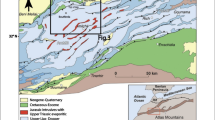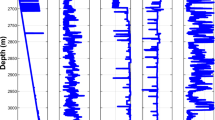Abstract
The seismic sedimentology is an emerging inter-discipline originating from the seismic stratigraphy and sequence stratigraphy. However, implementation of the seismic sedimentological research is found with high difficulties, due to influences imposed by structural and depositional background data (including strong reflections). In this paper, seismic records are regarded as a combination of the reflection from the depositional background and lithological data volumes, and moreover, the seismogram of the depositional background data is characterized by the low frequency and stable phase. Subsequently, the Kernel Hebbian Algorithm (KHA) has been modified to remove the influence of the depositional background data. The seismic trace data are used as the training set, and an innovative attempt has been made to incorporate the Ricker wavelet kernel function. Finally, a depositional background data volume extraction methodology with respect to input of higher-dimension seismic data has been developed, on the basis of the Modified KHA (MKHA), so as to obtain the lithological data volume. Utilizing the unsupervised online learning capabilities of the MKHA, iterative calculation of Kernel PCA can greatly reduce the computational complexity and can be adapted to big data problems. This paper introduces the Ricker wavelet kernel function to transform the original seismic data into the feature space through the inner-product operation, extract the non-linear features, and solve the problem that the seismic data of the original sample space is linearly inseparable. The seismic sedimentological analysis based on the lithological data volume that is able to reflect hidden sand bodies can achieve elaborate carving of the reservoir. The proposed method has been tested in Working Block A of the East-1 district in the Sulige gas field, the Ordos Basin, China. The case study demonstrates that the presented method is capable of efficiently removing the depositional background data, and making great contributions to improving accuracy of the seismic sedimentological analysis of the effective reservoir, with the help of higher-dimension seismic data.









Similar content being viewed by others
Notes
According to the KHA (Kim et al. 2005), in the Reproducing Kernel Hilbert Space (RKHS), \(b(t) = W(t)\phi (S(t))\). W is a weight matrix. \(\phi (S(t))\) is a pattern presented at time t which is randomly selected from the mapped data points \(\left\{ {\phi \left( {S_{1} } \right), \ldots \phi \left( {S_{m} } \right)} \right\}\). For notational convenience, we assume that there is a function \(J(t)\) which maps t to \(i \in \left\{ {1, \ldots ,m} \right\}\) ensuring \(\phi (S(J(t))) = \phi (S_{i} )\)and denote \(\phi (S(J(t)))\) simply by \(\phi (S(t))\). From the direct KPCA solution, it is known that \(W(t)\) can be expanded in the mapped data points \(\phi (S_{i} )\). This restricts the search space to linear combinations of the \(\phi (S_{i} )\) such that \(W(t)\) can be expressed as \(W(t) = A(t)\phi\) with a \(l \times m\) matrix \(A(t) = \left( {a_{1} (t)^{\text{T}} , \ldots a_{l} (t)^{\text{T}} } \right)^{\text{T}}\) of the weight expansion coefficients. The ith row \(a_{i} = \left( {a_{i1} , \ldots a_{im} } \right)\)of\(A(t)\) corresponds to the expansion coefficients of the ith eigenvector of K in the \(\phi (S_{i} )\), i.e., \(w_{i} \left( t \right) = \phi^{\text{T}} a_{i} \left( t \right)\).
References
Blumensath T, Davies ME (2008) Iterative thresholding for sparse approximations. J Fourier Anal Appl 14(5):629–654. https://doi.org/10.1007/s00041-008-9035-z
Castagna JP, Sun SJ (2003) Instantaneous spectral analysis: detection of low-frequency shadows associated with hydrocarbons. Lead Edge 22(2):120–127. https://doi.org/10.1190/1.1559038
Chakraborty A, Okaya D (1995) Frequency-time decomposition of seismic data using wavelet based methods. Geophysics 60(6):1906–1916. https://doi.org/10.1190/1.1443922
Deng XY, Yang DH, Xie J (2009) Noise reduction by support vector regression with a Ricker wavelet kernel. J Geophys Eng 6(2):177–188. https://doi.org/10.1088/1742-2132/6/2/009
Fomel S (2007) Shaping regulation in geophysical-estimation problems. Geophysics 72(2):R29–R36. https://doi.org/10.1190/1.2433716
Groot PD, Bruin GD, Hemstra N (1949) How to create and use 3D Wheeler transformed seismic volumes. SEG Tech Program Expand Abstr 25(1):1038. https://doi.org/10.1190/1.2369690
Hennenfent G, Fenelon L, Herrmann FJ (2010) Nonequispaced curvelet transform for seismic data reconstruction: a sparsity-promoting approach. Geophysics 75(6):WB203–WB210. https://doi.org/10.1190/1.3494032
Hernán MR, Henry WP, Janok PB (2011) Seismic geomorphology and high-resolution seismic stratigraphy of inner-shelf fluvial, estuarine, deltaic, and marine sequences, Gulf of Thailand. Am Assoc Pet Geol Bull 95(11):1959–1990. https://doi.org/10.1306/03151110134
Janocko M, Nemeca W, Henriksen S, Warchol M (2013) The diversity of deep water sinuous channel belts and slope valley fill complexes. Mar Pet Geol 41:7–34. https://doi.org/10.1016/j.marpetgeo.2012.06.012
Jin CZ, Qin YS (2017) Seismic strong shield removal based on the long and short cycle analysis. Oil Geophys Prospect 52(5):1042–1048. https://doi.org/10.13810/j.cnki.issn.1000-7210.2017.05.018
Kim KI, Franz MO, Schlkopf B (2005) Iterative kernel principal component analysis for image modeling. IEEE Trans Pattern Anal Mach Intell 27(9):1351. https://doi.org/10.1109/TPAMI.2005.181
Li HS, Yang WY, Tian J (2014) Coal seam strong reflection separation with matching pursuit. Oil Geophys Prospect 49(5):866–870. https://doi.org/10.13810/j.cnki.issn.1000-7210.2014.05.011
Liu JL, Wu YF, Han DH (2004) Time-frequency decomposition based on Ricker wavelet. SEG Tech Program Expand Abstr 23:1937–1940. https://doi.org/10.1190/1.1851176
Mallat SG, Zhang Z (1993) Matching pursuits with time-frequency dictionaries. IEEE Trans Signal Process 41(12):3397–3415. https://doi.org/10.1109/78.258082
Posamentier HW (2001) Seismic geomorphology and depositional systems of deep water environments; observations from offshore Nigeria, Gulf of Mexico, and Indonesia (abstract). AAPG Annu Conv Program 10:160. https://doi.org/10.1306/61EECBEE-173E-11D7-8645000102C1865D
Posamentier HW, Kolla V (2003) Seismic geomorphology and stratigraphy of depositional elements in deep water settings. J Sediment Res 73(3):367–388. https://doi.org/10.1306/111302730367
Sanger TD (1989) Optimal unsupervised learning in a single-layer linear feed forward neural network. Neural Netw 2(6):459–473. https://doi.org/10.1016/0893-6080(89)90044-0
Wang YH (2007) Seismic time-frequency spectral decomposition by matching pursuit. Geophysics 72(1):13–20. https://doi.org/10.1190/1.2387109
Wawrzyniak K (2010) Application of time-frequency transforms to processing of full waveforms from acoustic logs. Acta Geophys 58(1):49–82. https://doi.org/10.2478/s11600-009-0043-4
Wood LJ (2007) Quantitative seismic geomorphology of Pliocene and Miocene fluvial systems in the northern Gulf of Mexico, U. S. A. J Sediment Res 77:713–730. https://doi.org/10.2110/jsr.2007.068
Xu L, Wu XH, Zhang MZ, Yin XY, Zong ZY (2019) Strong reflection identification and separation based on the local-frequency-constrained dynamic matching pursuit. Oil Geophys Prospect 54(3):587–593. https://doi.org/10.13810/j.cnki.issn.1000-7210.2019.03.011
Zeng HL, Backus MM, Barrow KT, Tyler N (1998a) Stratal slicing: part I. Realistic 3-D seismic model. Geophysics 63(2):502–513. https://doi.org/10.1190/1.1444351
Zeng HL, Henry SC, Riola JP (1998b) Stratal slicing: part II. Real 3-D seismic data. Geophysics 63(2):514–522. https://doi.org/10.1190/1.1444352
Zeng HL, Zhao WZ, Xu ZH (2018) Carbonate seismic sedimentology: a case study of Cambrian Longwangmiao Formation, Gaoshiti-Moxi area, Sichuan Basin, China. Pet Explor Dev 45(5):775–784. https://doi.org/10.1016/S1876-3804(18)30086-7
Zhu XM, Zeng HL, Li SL, Dong YL, Zhu SF, Zhao DN, Huang W (2017) Sedimentary characteristics and seismic geomorphologic responses of shallow water delta of Qingshankou Formation in Songliao Basin, China. Mar Pet Geol 79:131–148. https://doi.org/10.1016/j.marpetgeo.2016.09.018
Zhu XM, Pan R, Li SL, Wang HB, Zhang X, Ge JW, Lu ZY (2018) Seismic sedimentology of sand gravel bodies on steep slope of rift basins a case study of Shahejie Formation, Dongying Sag, Eastern China. Interpretation 6(2):SD13–SD27. https://doi.org/10.1190/int-2017-0154.1
Zhu XM, Dong YL, Zeng HL, Huang HD, Liu QH, Qin W, Ye L (2019) New development trend of sedimentary geology: seismic sedimentology. J Palaeogeogr 21(2):189–201. https://doi.org/10.7605/gdlxb.2019.02.011
Acknowledgements
This work was financially supported by the National Science and Technology Major Project (2017ZX05001-003).
Author information
Authors and Affiliations
Corresponding author
Rights and permissions
About this article
Cite this article
Dou, Y. A method to remove depositional background data based on the Modified Kernel Hebbian Algorithm. Acta Geophys. 68, 701–710 (2020). https://doi.org/10.1007/s11600-020-00415-2
Received:
Accepted:
Published:
Issue Date:
DOI: https://doi.org/10.1007/s11600-020-00415-2




